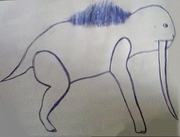(Adding categories) |
|||
| (6 intermediate revisions by the same user not shown) | |||
| Line 2: | Line 2: | ||
==All Todays description on mammoth== |
==All Todays description on mammoth== |
||
| − | Fossils of these large land mammals have been found throughout North America and Eurasia. They were one of the largest mammals of the late Cenozoic era and most likely lived in North America's and Eurasia's grasslands and forests. They were about the size of today's togars (gigantic grazing flightless birds). They had large tusks probably used for pulling down trees to feed on fruits and/or leaves. They were probably herd-dwellers much like elephants, which likely preferred warmer habitats such as rainforests and savannahs. They were likely cold-blooded and sluggish so therefore likely lived for 5,500 years due to their gigantic size and slow metabolism. They probably laid large eggs about the size of beach balls and the eggs probably hatched about 3-4 months after being laid. They probably became extinct due to competition from elephants (another extinct species) coming from their native ranges likely linked to climate changes. |
+ | Fossils of these large land mammals have been found throughout North America and Eurasia. They were one of the largest mammals of the late Cenozoic era and most likely lived in North America's and Eurasia's grasslands and forests. They were about the size of today's togars (gigantic grazing flightless birds). They also had brown fur tufts coming from their upper backs, as evidenced by some fossils of the mammoths and some studies on their fossilized melanosomes (pigment cells) in the fossil mammoths. They had large tusks probably used for pulling down trees to feed on fruits and/or leaves. They were probably herd-dwellers much like elephants, which likely preferred warmer habitats such as rainforests and savannahs. They were likely cold-blooded and sluggish so therefore likely lived for 5,500 years due to their gigantic size and slow metabolism. They probably laid large eggs about the size of beach balls and the eggs probably hatched about 3-4 months after being laid. They probably became extinct due to competition from elephants (another extinct species) coming from their native ranges likely linked to climate changes. |
| + | |||
| + | ==Introduction to real life North America== |
||
| + | Since real life humans had introduced all todays mammoths to real life North America, these large mostly-hairless herbivorous mammals now coexist alongside real mammoth species and other elephant species. Unlike their ancestors, all todays mammoths are now peaceful to any sapient species/beings and to dylanusids, as they adapted into human settlements and learned to tolerate human activities and among others, so they now flourish alongside real mammoth species and are now very tame towards any sapient species. |
||
[[Category:Custom Animals]] |
[[Category:Custom Animals]] |
||
[[Category:Custom Species]] |
[[Category:Custom Species]] |
||
| Line 12: | Line 15: | ||
[[Category:Extinct Species]] |
[[Category:Extinct Species]] |
||
[[Category:Extinct Animals]] |
[[Category:Extinct Animals]] |
||
| + | [[Category:Custom Extinct Animals]] |
||
| + | [[Category:Fictional Extinct Species]] |
||
| + | [[Category:Former Extinct Species]] |
||
| + | [[Category:Former Fictional Species]] |
||
| + | [[Category:Mammals]] |
||
| + | [[Category:Custom Mammals]] |
||
| + | [[Category:Custom North American Animals]] |
||
| + | [[Category:Custom Asian Animals]] |
||
| + | [[Category:Custom European Animals]] |
||
| + | [[Category:Animals]] |
||
| + | [[Category:Herbivores]] |
||
| + | [[Category:Custom Non-Domestic City Animals]] |
||
Latest revision as of 02:42, 24 May 2018

A possible restoration of a mammoth.
All Todays mammoth is a formerly fictional outdated-looking species of elephant that now exist in real life North America (along with real elephant species).
All Todays description on mammoth
Fossils of these large land mammals have been found throughout North America and Eurasia. They were one of the largest mammals of the late Cenozoic era and most likely lived in North America's and Eurasia's grasslands and forests. They were about the size of today's togars (gigantic grazing flightless birds). They also had brown fur tufts coming from their upper backs, as evidenced by some fossils of the mammoths and some studies on their fossilized melanosomes (pigment cells) in the fossil mammoths. They had large tusks probably used for pulling down trees to feed on fruits and/or leaves. They were probably herd-dwellers much like elephants, which likely preferred warmer habitats such as rainforests and savannahs. They were likely cold-blooded and sluggish so therefore likely lived for 5,500 years due to their gigantic size and slow metabolism. They probably laid large eggs about the size of beach balls and the eggs probably hatched about 3-4 months after being laid. They probably became extinct due to competition from elephants (another extinct species) coming from their native ranges likely linked to climate changes.
Introduction to real life North America
Since real life humans had introduced all todays mammoths to real life North America, these large mostly-hairless herbivorous mammals now coexist alongside real mammoth species and other elephant species. Unlike their ancestors, all todays mammoths are now peaceful to any sapient species/beings and to dylanusids, as they adapted into human settlements and learned to tolerate human activities and among others, so they now flourish alongside real mammoth species and are now very tame towards any sapient species.
